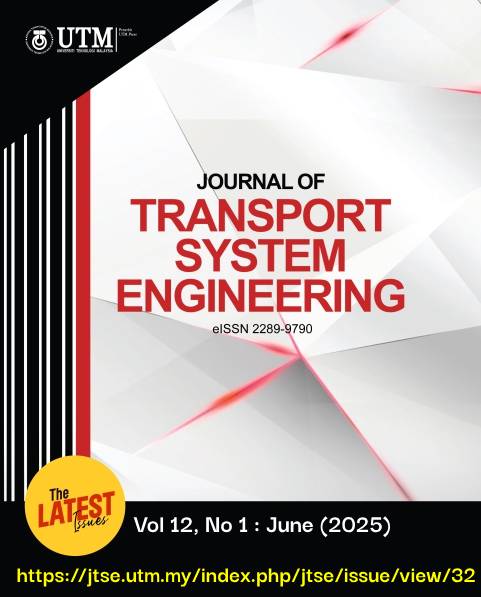Modelling of Bearing Lubrication for Electric Vehicle Motor Bearing
DOI:
https://doi.org/10.11113/jtse.v12.241Keywords:
Point Contact, Elastohydrodynamic (EHL), Current Discharge, Electric Vehicle.Abstract
Bearing failure in electric motors is increasingly attributed to complex electro-thermal interactions that accelerate surface damage and lubricant degradation. Electrical current discharge disrupts the lubricant’s rheological properties, diminishing film thickness and undermining protection in the elastohydrodynamic lubrication regime. This study presents a numerical model that integrates EHL theory with heat generation from shear and electrical sources while capturing the influence of key operating parameters such as shaft speed, bearing resistivity, and temperature. The findings reveal that current discharge markedly reduces minimum film thickness and distorts pressure distribution due to localised temperature rise and viscosity breakdown. The model demonstrates strong predictive capability by capturing the coupled effects of entrainment, rheological degradation, and electro-thermal loading. These results underscore the sensitivity of EHL film formation to electrical stress and highlight potential failure thresholds under realistic operating conditions. The insights gained can inform the development of advanced bearing systems with enhanced thermal management, electrical insulation, and lubricant formulation strategies, ultimately improving the durability and reliability of electric motor drivetrains.
References
Zhang, He, F., Xie, G., & Luo, J. (2020). Electrical bearing failures in electric vehicles. Friction, 8(1), 4–28. https://doi.org/10.1007/s40544-019-0316-3
Chen, Y., Jha, S., Raut, A., Zhang, W., & Liang, H. (2020). Performance characteristics of lubricants in electric and hybrid vehicles: A current and future needs review. Frontiers in Mechanical Engineering, 6, 571464. https://doi.org/10.3389/fmech.2020.571464
Lee, W. B., & Orr, D. E. (2022). The Triboelectric Effect Series. AlphaLab, Inc. Retrieved June 30, 2024, from https://www.alphalabinc.com/wp-content/uploads/2024/02/The-Triboelectric-Effect-Series-AlphaLab-Inc.pdf
Wang, J., Zhou, L., Zhang, C., & Wang, Z. L. (2019). Small-scale energy harvesting from environment by triboelectric nanogenerators. In R. Manyala (Ed.), Small-Scale Energy Harvesting (Chapter 4, pp. 63–94). IntechOpen. https://doi.org/10.5772/intechopen.82023
Mohamed Ariffin, N. A. A., Lee, C. T., Thirugnanasambandam, A., Wong, K. J., & Chong, W. W. F. (2024). Triboelectric performance of ionic liquid, synthetic, and vegetable oil-based polytetrafluoroethylene (PTFE) greases. Lubricants, 12(8), 272. https://doi.org/10.3390/lubricants12080272
Chong, W. W. F., Teodorescu, M., & Rahnejat, H. (2014). Mixed thermo-elastohydrodynamic cam–tappet power loss in low-speed emission cycles. International Journal of Engine Research, 15(2), 153–164. https://doi.org/10.1177/1468087413492841
Hamrock, B. J., & Dowson, D. (1977). Isothermal elastohydrodynamic lubrication of point contacts: Part III—Fully flooded results. Journal of Lubrication Technology, 99(2), 264–275. https://doi.org/10.1115/1.3453115
Karthikeyan, B. K., Teodorescu, M., Rahnejat, H., & Rothberg, S. J. (2010). Thermoelastohydrodynamics of grease-lubricated concentrated point contacts. Proceedings of the Institution of Mechanical Engineers, Part C: Journal of Mechanical Engineering Science, 224(3), 683–695. https://doi.org/10.1243/09544062JMES1654
Prashad, H. (2005). Tribology in electrical environments. Elsevier.
Ariffin, N. A. A. M., Pui, Y. H., Bao, L. M., Hamdan, S. H., & Chong, W. W. F. (2023). Tribological performance of perfluoropolyether (PFPE)-based grease for potential application in electric motor bearings. Journal of Transport System Engineering, 6(2), 60–65.
Downloads
Published
How to Cite
Issue
Section
License
Copyright of articles that appear in Journal of Transpot System Engineering (JTSE) belongs exclusively to Penerbit Universiti Teknologi Malaysia (Penerbit UTM Press). This copyright covers the rights to reproduce the article, including reprints, electronic reproductions or any other reproductions of similar nature.
Disclaimer: The views and opinions expressed in the articles are those of the authors and do not necessarily reflect the official policy or position of the JTSE. Examples of analysis performed within are only examples and they should not be utilized in real-world. Assumptions made within the analysis are not reflective of the position of any JTSE entities.


















